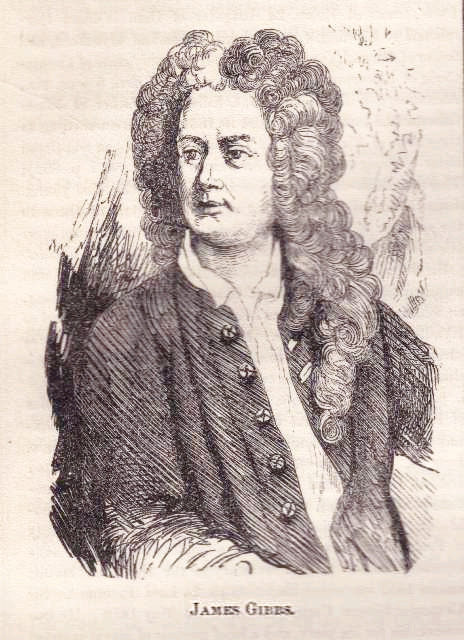GIBBS, JAMES,
an eminent architect, the son of Peter Gibbs, of Foot-dee-mire, merchant
in Aberdeen, and Isabel Farquhar, his second wife, was born about 1674.
He received his education at the grammar school and the Marischal
college, Aberdeen, where he took the degree of M.A. An anecdote is
recorded of Peter Gibbs the father, which deserves to be related as an
evidence of the spirit of the times. At the Revolution of 1688, party
feeling running high, old Mr. Gibbs, who was a Roman Catholic, named two
dogs he had Calvin and Luther, in derision of both Presbyterians and
Episcopalians. For this the magistrates of Aberdeen summoned him to
appear before them, and sagaciously ordered the unoffending puppies to
be hanged at the cross as a terror to evil-doers, which wise, and just,
and merciful sentence was duly executed accordingly!
About 1694 Mr.
James Gibbs left Aberdeen, to which he never returned, and spent some
years in the service of an architect and master-builder in Holland. The
earl of Mar happening, about 1700, to be in that country, Mr. Gibbs was
introduced to him, and finding him to be a man of genius, his lordship
generously furnished him with recommendatory letters and money, in
order, by travelling, to complete himself as an architect. Mr. Gibbs
accordingly went to Italy, and for ten years applied himself assiduously
to the study of architecture among the classical models of ancient Rome.
In 1710 he returned to England, when, by the influence of his noble
patron, then secretary for Scotland, and high in favour with Queen Anne,
his name was added to the list of architects appointed by the trustees
named in the act of parliament which had been passed for building fifty
new churches in the metropolis. He designed and executed the church of
St. Martin’s-in-the-Fields, the beautiful façade of which is considered
his chef-d’oeuvre, St. Mary’s in the Strand, and others. The
Radcliffe Library at Oxford, on the completion of which he received the
degree of M.A. from that university; the King’s college, Royal library,
and Senate house at Cambridge; and the monument of John Holles, duke of
Newcastle, in Westminster Abbey, with some buildings in the palace of
Stowe, are also lasting evidences of his abilities as an architect. A
few years before his death he sent to the magistrates of Aberdeen, as a
testimony of his regard for his native place, a plan of St. Nicholas
church in that city, which was followed in the rebuilding of it.

[portrait of James Gibbs]
He died unmarried August 5, 1754, and bequeathed the bulk of his
property, amounting to about £15,000, to public charities, and his
particular friends; amongst the rest he left £1,000, the whole of his
plate, and an estate of £280 a-year, to the only son of his patron, the
earl of Mar. In 1728 he had published a large folio volume of his
designs, by which he realized £1,500, and sold the plates afterwards for
£400. His papers and MSS., with his library, consisting of about 500
volumes, he left as a donation to the Radcliffe Library.
His works are:
Book of Architecture; containing designs of buildings and ornaments.
Lond. 1728, fol.
Rules for drawing the several parts of Architecture in a more exact and
easy manner than has hitherto been practised; with cuts. Lond. 1732,
1738, fol.
Short Description of the Radcliffe Library at Oxford; containing its
several plans, uprights, sections, and ornaments, on twenty-three
copperplates; with the explication of each plate. Lond. 1747, fol.
The History of the Portuguese, during the reign of Emmanuel; containing
all their Discoveries from the Coast of Africk to the farthest parts of
China; their Battles by Sea and Land, &c.; including also their
discovery of the Brazila. From the Latin of Osorio. Lond. 1752, 2 vols.
8vo.

